Grandmaster Hans Moke Niemann made a few statements on Sunday – both in his round 3 game, and in his post-game interview – at the 2021 U.S. Junior Championship.
Against the French defense, Niemann scored against the Junior field’s top-seed GM Nicolas Checa on Sunday, sacrificing his knight at 19. Nxg6! to uncork a vicious winning attack. After collecting the full point, Niemann went on to explain his thinking to the Saint Louis Chess Club broadcast crew, realizing in the middle of his calculations: “’Oh, I’m going to win this tournament...’”
The prognostication may not be the opinion of IM Christopher Yoo, who is tied with Niemann for the lead at 2.5/3 after picking up his second win of the event on Sunday over IM Ben Li. Niemann's opinion may also not be shared by reigning Juniors champion GM John Burke, who sits just a half-point behind the leaders after picking up his first win over GM Brandon Jacobson in round 3.
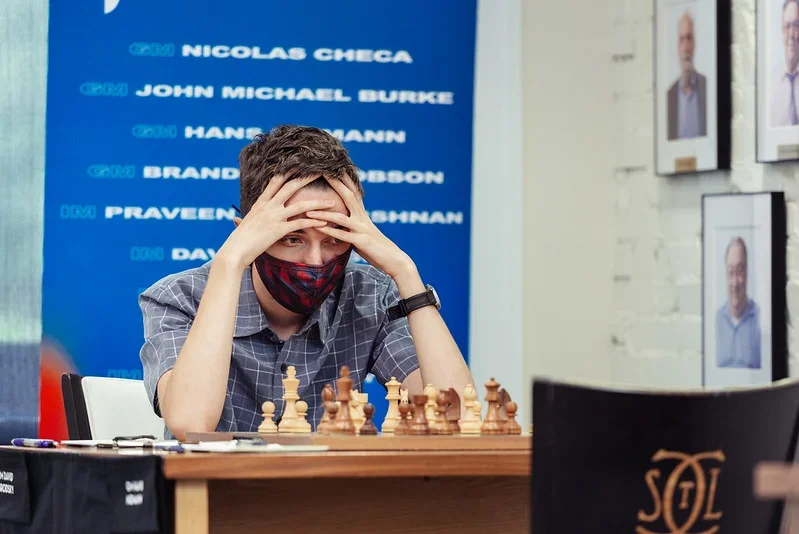
Also sharing second place at 2.0/3 is IM David Brodsky, who has had a solid start to the 2021 Juniors Championship, including two draws against Niemann and Checa. On Sunday, Brodsky caught up with the chasing pack with his first win of the event over IM Andrew Hong, in the U.S. Junior Championship Round 3 Game of the Day, annotated by FM Robert Shlyakhtenko.
[pgn][Event "US Junior champs"] [Site "?"] [Date "2021.07.18"] [Round "?"] [White "Brodsky, David"] [Black "Hong, Andrew"] [Result "1-0"] [ECO "C45"] [Annotator "Shlyakhtenko,Robert"] [PlyCount "67"] [EventDate "2021.07.17"] 1. e4 e5 2. Nf3 Nc6 3. d4 exd4 4. Nxd4 Nf6 5. Nxc6 bxc6 6. e5 Qe7 7. Qe2 Nd5 8. h4 f6 ({At the World Cup, Cheparinov managed to twice gain some advantage against another popular try,} 8... Qe6) 9. c4 Ba6 10. Rh3 Nb4 $6 {My guess is that Andrew simply misremembered something here.} (10... fxe5 {is the main move, after which we are able to see the ideas of 8. h4 and 10. Rh3.} 11. Bg5 Nf6 12. Re3 O-O-O 13. Ra3 $5 (13. Rxe5 Qb4+ 14. Nc3 Bd6 $17 {0-1 (24) Perunovic,M (2589)-Nihal,S (2612) Moscow 2019}) 13... Bb7 14. Rxa7 {with a complicated position, seen in several recent games.}) ({Similar positions to the game were reached after} 10... Nb6 11. exf6 Qxe2+ 12. Bxe2 Bxc4 13. Re3+ Kf7 (13... Kd8 $5) 14. fxg7 Bxg7 15. Bh5+ Kf8 {, ½-½ (144) Cheparinov,I (2667)-Jones,G (2702) Hengshui 2019, and now} 16. Nc3 $1 {seems strong, with the plan of Bd2 and 0-0-0.}) 11. a3 Nd5 12. b4 ({A better way to consolidate was} 12. Qe4 Nb6 13. Re3 {, and black is in serious trouble.} O-O-O 14. c5 $1 { does not work for black.}) 12... Nb6 13. exf6 ({There were alternatives, such as} 13. Nd2 $5 fxe5 14. Bb2 O-O-O {and now I like the prophylactic} 15. Rc1 $1 {, intending} (15. Qd1 $5 {, with the idea of c5, is also not bad.}) 15... d5 $2 16. b5 $16) 13... Qxe2+ 14. Bxe2 Bxc4 15. Re3+ Kf7 ({In Cheparinov's game} 15... Kd8 $2 {was a serious option, but here white is able to play} 16. Bb2 $18 ) 16. fxg7 Bxg7 {This endgame is very sharp. A lot depends on dynamic factors, specifically piece activity.} 17. Bh5+ Kg8 (17... Kf8 18. Rf3+ {would most likely lead to the same position.}) 18. Rg3 {White's goal is to "stalemate" black on the kingside.} h6 ({Black should not have let his pieces become passive, at least from a practical perspective. I prefer} 18... Bf7 19. Bb2 Bg6 $1 20. Bxg6 Bxb2 21. Bf5+ Kf7 22. Ra2 Bf6 {and white must play very precisely even to hope for an advantage.}) 19. Bb2 Rh7 20. Nc3 Bf7 21. Be2 {Correct. Trading pieces would have helped black fix the logjam on the kingside.} Kh8 { Sacrificing the exchange, which would free black's pieces. However, Brodsky finds a very deep idea.} ({On the other hand, black should have insisted on the trade:} 21... Bc4 22. Ne4 Bxe2 23. Kxe2 Kf7 $14) 22. O-O-O $5 {Not going for material. White realizes that the most important point is to keep black's h7-rook out of the game. If he can achieve that, he is winning.} ({The natural } 22. Bd3 {would allow black to create a mess:} Nc4 23. O-O-O Nxb2 24. Kxb2 Bh5 25. Re1 (25. Rd2 Bxc3+ 26. Kxc3 Re7 {also allows black to play on, though the endgame is difficult.}) 25... Bd4 $1 26. Bxh7 Bxf2 27. Rge3 Bxe1 28. Rxe1 Kxh7 29. Re7+ Kg6 30. Rxd7 Rc8 {I can imagine white going wrong here.}) 22... Be5 $2 {The practical problems facing black are immense. Surprisingly, this move is already the losing mistake.} ({Black's position was very difficult, but not yet wholly bad. A stronger defense was the preliminary} 22... d6 {, aiming to meet} 23. Bd3 {with} Be5) 23. Re3 $1 {White the only refutation. Otherwise, black would have been able to activate the h7-rook.} Bf6 ({The big point is} 23... d6 24. Rxe5 $1 dxe5 25. Ne4 {and black cannot save the e5-pawn.} Nd5 ( 25... Re8 26. Nf6 $18) 26. Bxe5+ Kg8 27. Rd3 $1 {with a very powerful initiative.}) 24. Rf3 $1 {Continuing to chase the bishop.} Bxh4 {Desperation.} ({This time,} 24... Be5 {would be met with} 25. Rf5 d6 26. f4 $1) 25. Bd3 { The point of this move is not so much to win an exchange, but to create a deadly pin on the a1-h8 diagonal.} Rg7 26. Ne4 Bg6 27. Rh1 Bxe4 {It seems that after white recaptures, black can give a check on g5 and move his king, maintaining at least some hopes of respite. However, white finds a beautiful riposte in the form of an intermediate move.} 28. Rf7 $1 Bg5+ 29. Kd1 Rag8 30. f4 $1 {Brutal -- white is still not taking on e4.} Bxd3 31. fxg5 Nc4 32. Ba1 Nd6 33. Rxh6+ Bh7 34. g6 {A beautiful final position. Black is still up a knight, but cannot avoid checkmate.} 1-0 [/pgn]

2021 U.S. Senior Championship
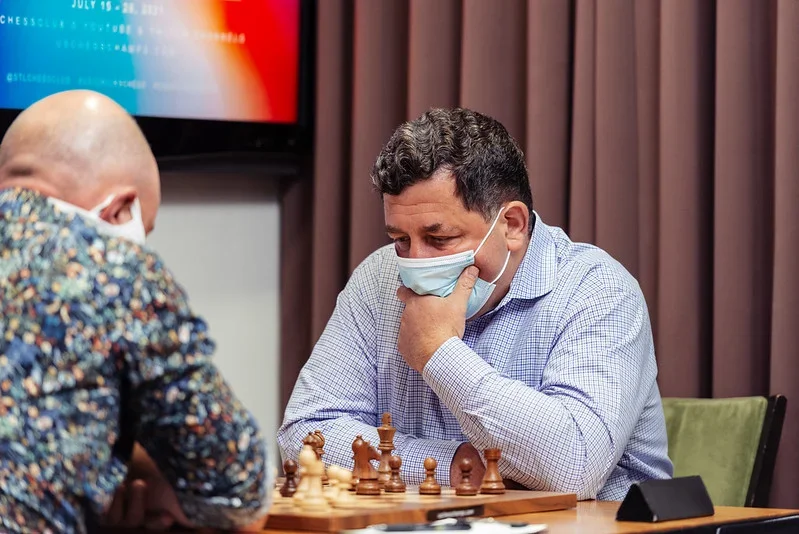
GM Gregory Kaidanov is still the clear leader of the the 2021 U.S. Senior Championship, though he slowed his perfect pace with a third-round draw to famed US Chess coach Melikset Khachiyan in round 3.
A half-point behind is GM Larry Christiansen and IM Leonid Sokolin, the tournament wildcard and the only International Master in the 2021 Seniors field. Sokolin has now put together back-to-back wins, including yesterday's round 2 victory over Khachiyan, and Sunday’s round 3 win as Black against GM Alexander Shabalov – the U.S. Senior Championship Round 3 Game of the Day, annotated by FM Robert Shlyakhtenko.
[pgn][Event "US Senior champs"] [Site "?"] [Date "2021.07.18"] [Round "?"] [White "Shabalov, Alexander"] [Black "Sokolin, Leonid"] [Result "0-1"] [ECO "A20"] [Annotator "Shlyakhtenko,Robert"] [PlyCount "116"] [EventDate "2021.07.17"] 1. c4 e5 2. g3 c6 3. Nf3 {This is currently considered to be the most critical try against 2...c6.} e4 4. Nd4 d5 5. cxd5 Qxd5 6. Nc2 Nf6 7. Nc3 Qe5 8. Bg2 Be7 {I'm not sure if this move order is better than 8...Na6, since in some cases the bishop could have gone to c5.} (8... Na6 9. O-O (9. Ne3 {now ...Be7 would transpose to the game, but} Bc5 $5 {is probably a better move.}) 9... Be7 10. Nxe4 $5 {is a remarkable idea of Van Foreest from the Prague Masters, which attracted a lot of attention to this line.} Nxe4 11. f4 Qe6 12. f5 Qd5 13. d4 { and white had serious compensation, ½-½ (80) Van Foreest,J (2701)-Navara,D (2697) Prague 2021}) 9. Ne3 ({Black's point is that} 9. O-O O-O 10. Nxe4 $6 { no longer works as well:} Nxe4 11. f4 Qe6 12. f5 Qd5 13. d4 Bf6 14. g4 Re8 { , and white does not have enough for the piece.}) 9... Na6 10. Qc2 Nc5 { A novelty.} ({In previous games, black preferred to sacrifice the e4-pawn:} 10... Nb4 11. Qb1 Be6 12. a3 (12. Nxe4 Nxe4 13. Qxe4 Qxe4 14. Bxe4 Nxa2 { and black will take the c1-bishop, with a good position.}) 12... Nbd5 13. Nxe4 Nxe3 14. dxe3 O-O-O {with decent compensation.}) 11. b4 ({White's best chance for an advantage might be} 11. b3 Ne6 {(otherwise Bb2, threatening various knight discoveries, is unpleasant)} 12. Bb2 Nd4 13. Qb1 Qh5 14. h3 {, reaching positions similar to the game, but the position of the pawn on b3 rather than on b4 is helpful for white. Firstly, the pawn is simply not hanging, and secondly, Nc4 becomes a useful possibility in some lines.}) 11... Ne6 12. Bb2 Nd4 13. Qb1 Qh5 14. h3 {It may seem that white is better in view of the weak e4-pawn, but Sokolin finds a great solution in the spirit of the variation.} O-O $1 {A very typical pawn sacrifice for this line.} 15. g4 {More or less forced, as it's not clear how else white can complete development.} Qe5 16. Nxe4 Rd8 {Black's excellent centralization makes it difficult for white to consolidate the extra pawn. All the time he has to worry about the undermining moves ...h5 and ...a5.} 17. Bc3 h5 18. a4 ({If white wanted to play Qd3, he probably should have done so immediately.} 18. Qd3 Nxe4 (18... Bxb4 $2 { as in the game does not work, for example:} 19. f4 Qxf4 20. Bxd4 Nxe4 21. Bxe4 c5 22. Bh7+ Kh8 23. Bxg7+) 19. Qxe4 Qxe4 20. Bxe4 Nb5 $1 {After capturing on c3 black will play ...Bf6 and ...a5, with counterplay. So perhaps white should consider giving back the pawn with} 21. Bb2 $5 Bxb4 22. Bd3 h4 23. f4 {With an unbalanced endgame in which I would probably play white.}) 18... Be6 19. Qd3 $2 {A risky move that turns out to be a blunder.} (19. Nf5 $5 {is the engine suggestion, to relieve some of the pressure.} Bxf5 20. gxf5 Bxb4 $5 (20... Qxf5 21. Rg1 {is better for white, as the two bishops in conjunction with play on the g-file can become very strong.}) 21. f4 $1 {The only move. Either recapture on b4 would be met with ...Nc2+.} Qe7 22. Bxb4 Qxb4 23. Nxf6+ gxf6 24. Qxb4 Nc2+ 25. Kf2 Nxb4 {A position with an unusual pawn structure. Both sides have their plusses, as black can entrench the knight on b4 with ...a5, and white can try to advance the central pawns with Rhd1 followed by d4 and e4. }) 19... Bxb4 $1 {A nice tactical shot. The point is to deflect white's c3-bishop before playing ...Nf3+.} (19... Nf3+ $2 20. Bxf3 Rxd3 21. Bxe5 { does not work.}) 20. f4 {The best try.} Qxf4 21. Bxd4 Nxe4 22. Bxe4 c5 { This move was the point of black's combination. He wins back the piece with a nearly decisive advantage.} 23. Bh7+ Kh8 24. Nc2 Bxd2+ $1 25. Qxd2 Qxd2+ 26. Kxd2 Kxh7 27. e3 Rac8 {Good technique -- there is no rush to take on d4.} 28. Rab1 Bd5 29. Rhf1 Be4 30. Rb2 Bxc2 $2 {This trade, however, seriously endangers the win. Not without reason did Tarrasch say that all rook endgames are drawn -- black should have kept the superior minor piece on the board.} ( 30... cxd4 31. Nxd4 hxg4 32. hxg4 Rd7 {is technically winning for black. White's a4- and g4- pawns are weak, and he will not be able to stop black from eventually creating a passed pawn.}) 31. Rxc2 cxd4 32. Rxc8 dxe3+ 33. Kxe3 Rxc8 34. Rxf7 hxg4 ({A better move order was} 34... Rc3+ {, since} 35. Kf4 {(as in the game) loses to} Rxh3 36. Rxb7 Rh4 $1) 35. hxg4 Rc3+ 36. Kf4 $1 Rc4+ 37. Kg5 Rxa4 38. Rxb7 {The draw is within reach for white, as he is able to prevent black from activating his king.} Ra5+ 39. Kh4 Kh6 40. Rb3 $2 {The first mistake, although not yet a decisive one. White should have kept the rook active.} (40. Rc7 {any rook move on the 7th rank was fine.} g5+ 41. Kg3 Ra3+ 42. Kf2 a5 43. Rc6+ Kg7 44. Rc5 {This is the point. Black cannot escape threats from the rook without sacrificing the g5-pawn.} Kf6 45. Rc6+ Ke5 46. Rc5+ Kd4 ({or} 46... Kf4 47. Rc4+) 47. Rxg5 {with a draw.}) 40... g5+ 41. Kg3 Re5 $1 {An excellent move: black cuts off white's king, and prepares his own king's march to the queenside. White cannot easily create counterplay, since the rook e5 will be able to defend both pawns.} 42. Kf3 Kg6 43. Rb7 a5 44. Rd7 Kf6 45. Rd8 Ke6 46. Rd4 Rd5 47. Rc4 Rb5 48. Ke3 Kd5 49. Rd4+ $2 {This is the losing move. The big problem is that black's king is able to escape from any checks given from the side or from behind the pawn.} ({Thus, the only way to draw was to go in front of the pawn:} 49. Ra4 $1 Kc5 50. Ra1 $1 {Black cannot push the a-pawn any further:} Kb6 (50... Kb4 51. Rb1+ {does not change anything.}) 51. Ke4 $1 {and white is able to activate his king in time.} Rb4+ { is met with} 52. Kf5) 49... Kc6 50. Re4 Rd5 51. Re8 Kb5 52. Ke4 Rc5 53. Kd3 a4 54. Rb8+ Ka5 55. Kd4 Rb5 {Black will block any checks by keeping the rook on the 5th rank. At the same time, white is unable to activate his own king.} 56. Rc8 Kb4 57. Kd3 Rd5+ 58. Ke4 Rc5 0-1 [/pgn]
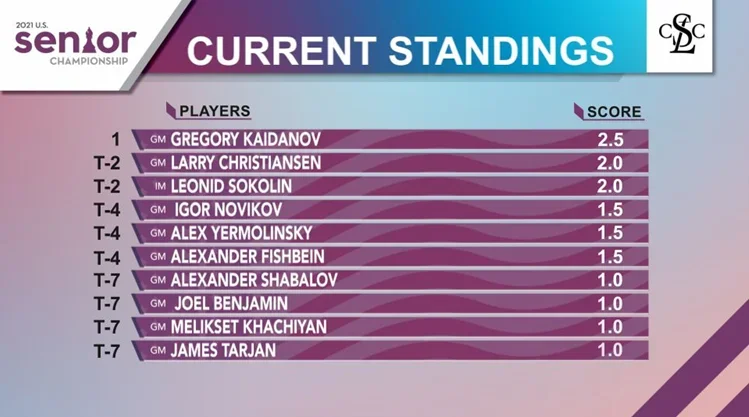
U.S. Junior Girls
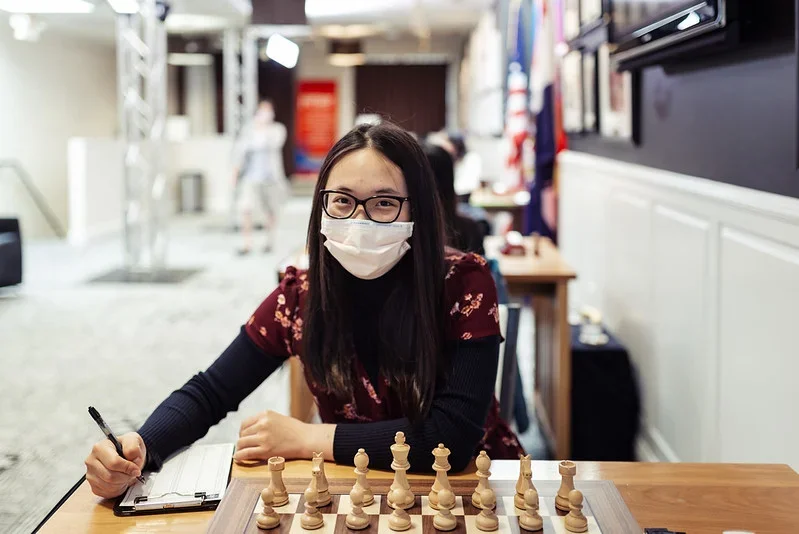
IM Annie Wang is now the clear leader of the 2021 U.S. Girls Championship, and the last of 30 players in the Saint Louis Chess Club to maintain a perfect score after three rounds. Wang scored her third win of the event Sunday as White over Susanna Ulrich, taking clear lead after fellow co-leader FM Thalia Cervantes lost pace with her a loss as Black to WCM Ruiyang Yan. Both Yan and Cervantes now join a four-player chasing pack in second place at 2/3, along with WIM Rochelle Wu and WCM Sheena Zeng.
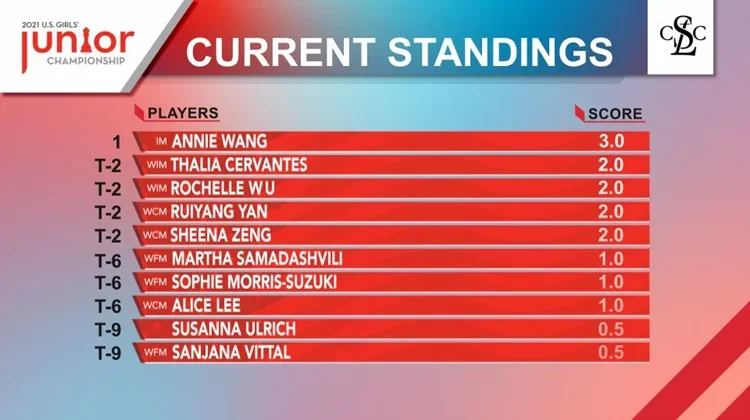
Each round of the 2021 U.S. Juniors and Senior Championships begins daily at 3:00 p.m. central time, along with live commentary from GMs Yasser Seirawan and Cristian Chirila, and host Sharon Carpenter on www.uschesschamps.com or the Saint Louis Chess Club’s YouTube and Twitch channels.
Categories
Archives
- December 2025 (26)
- November 2025 (29)
- October 2025 (39)
- September 2025 (27)
- August 2025 (29)
- July 2025 (43)
- June 2025 (25)
- May 2025 (24)
- April 2025 (29)
- March 2025 (29)
- February 2025 (20)
- January 2025 (24)
- December 2024 (34)
- November 2024 (18)
- October 2024 (35)
- September 2024 (23)
- August 2024 (27)
- July 2024 (44)
- June 2024 (27)
- May 2024 (31)
- April 2024 (51)
- March 2024 (34)
- February 2024 (25)
- January 2024 (26)
- December 2023 (29)
- November 2023 (26)
- October 2023 (37)
- September 2023 (27)
- August 2023 (37)
- July 2023 (47)
- June 2023 (33)
- May 2023 (37)
- April 2023 (45)
- March 2023 (37)
- February 2023 (28)
- January 2023 (31)
- December 2022 (23)
- November 2022 (32)
- October 2022 (31)
- September 2022 (19)
- August 2022 (39)
- July 2022 (32)
- June 2022 (35)
- May 2022 (21)
- April 2022 (31)
- March 2022 (33)
- February 2022 (21)
- January 2022 (27)
- December 2021 (36)
- November 2021 (34)
- October 2021 (25)
- September 2021 (25)
- August 2021 (41)
- July 2021 (36)
- June 2021 (29)
- May 2021 (29)
- April 2021 (31)
- March 2021 (33)
- February 2021 (28)
- January 2021 (29)
- December 2020 (38)
- November 2020 (40)
- October 2020 (41)
- September 2020 (35)
- August 2020 (38)
- July 2020 (36)
- June 2020 (46)
- May 2020 (42)
- April 2020 (37)
- March 2020 (60)
- February 2020 (38)
- January 2020 (45)
- December 2019 (34)
- November 2019 (35)
- October 2019 (42)
- September 2019 (45)
- August 2019 (56)
- July 2019 (44)
- June 2019 (35)
- May 2019 (40)
- April 2019 (48)
- March 2019 (61)
- February 2019 (39)
- January 2019 (30)
- December 2018 (29)
- November 2018 (51)
- October 2018 (45)
- September 2018 (29)
- August 2018 (49)
- July 2018 (35)
- June 2018 (31)
- May 2018 (39)
- April 2018 (31)
- March 2018 (26)
- February 2018 (33)
- January 2018 (30)
- December 2017 (26)
- November 2017 (24)
- October 2017 (30)
- September 2017 (30)
- August 2017 (31)
- July 2017 (28)
- June 2017 (32)
- May 2017 (26)
- April 2017 (37)
- March 2017 (28)
- February 2017 (30)
- January 2017 (27)
- December 2016 (29)
- November 2016 (24)
- October 2016 (32)
- September 2016 (31)
- August 2016 (27)
- July 2016 (24)
- June 2016 (26)
- May 2016 (19)
- April 2016 (30)
- March 2016 (36)
- February 2016 (28)
- January 2016 (32)
- December 2015 (26)
- November 2015 (23)
- October 2015 (16)
- September 2015 (28)
- August 2015 (28)
- July 2015 (6)
- June 2015 (1)
- May 2015 (2)
- April 2015 (1)
- February 2015 (3)
- January 2015 (1)
- December 2014 (1)
- July 2010 (1)
- October 1991 (1)
- August 1989 (1)
- January 1988 (1)
- December 1983 (1)







